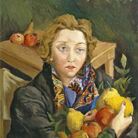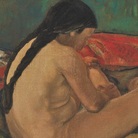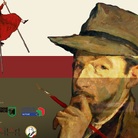Jasa. Utter. The violent necessity for the embodied presence of hope

Dal 7 May 2015 al 22 November 2015
Venezia
Luogo: Artiglierie dell'Arsenale
Indirizzo: Campo Arsenale
Curatori: Michele Drascek, Aurora Fonda
Enti promotori:
- UGM / Galleria d’Arte di Maribor
- Ministero della Cultura della Repubblica di Slovenia
- WEARE Production
Costo del biglietto: ingresso gratuito
Telefono per informazioni: +39 041 8501468
E-Mail info: info@aplusa.it
Sito ufficiale: http://www.utter-project.net
UGM / Galleria d’Arte di Maribor, il Ministero della Cultura della Repubblica di Slovenia e WEARE Production sono lieti di presentare “UTTER / The violent necessity for the embodied presence of hope”, un nuovo progetto di JAŠA. L’artista rappresenterà la Slovenia alla 56a Biennale di Venezia - Esposizione Internazionale d’Arte. Il titolo del progetto suggerisce lo scopo alla base del lavoro di JAŠA: creare un’opera d’arte che sia una presa di posizione poetica, dinamica e politica.
L’opera è stata concepita come un’installazione e una performance site-specific che renderà partecipi sia l’artista e i suoi collaboratori che il pubblico per tutta la durata della Biennale. Il progetto è costituito da una struttura architettonica la cui funzione è quella di attivare una rifrazione di pensieri attraverso una performance estesa nel tempo che esprime la necessità di (re)agire. Questi elementi coesistono e s’intrecciano formando l’essenza del lavoro.
Il progetto “Utter / The Violent Necessity for the Embodied Presence of Hope” ruota attorno a tre temi principali: resistenza, collaborazione e speranza. La forza espressiva di ogni tema sarà determinata dalla coesistenza di azioni performative ripetitive e dalla produzione di momenti armonici all’interno dell’involucro architettonico. Una situazione polifonica comprendente elementi visivi, sonori e performativi, che seguirà un rigoroso copione settimanale, ripetuto 28 volte (dal 9 maggio fino al 22 novembre), abitando lo spazio del padiglione per tutto il periodo della Biennale. In tal modo il progetto di JAŠA usa la piattaforma della Biennale di Venezia non come una temporanea esposizione di realtà parallele, ma piuttosto come un criterio di condotta opposto alla realtà predominante. È convinzione dell’artista che un’opera d’arte può assumere carattere politico solo quando l’ideologia che la indirizza è ispirata, non imposta. Se si considerano sia le esigenze pratiche e sia i momenti estatici di una performance, il progetto è un atto di disciplina strutturato, un appello rivolto alla sensibilità collettiva.
Attraverso azioni ripetitive e continue, gesti e la trasformazione di questi in rituali, il gruppo di performer radunerà intorno a sé una forza rivoluzionaria, che attraverso il potere dell’atto poetico, esorterà alla realizzazione pandemica delle idee di comunità e unificazione.
“Il mio scopo è l’uso del Padiglione della Slovenia come base di confronto con il pubblico internazionale, che verrà coinvolto nell’esperienza di un progetto totale, un meccanismo operativo vivo guidato dalla solidarietà di tutte le parti incluse: installazione, elementi visivi, luci, proiezioni, suono e performance. Intendo quindi creare un’esperienza di unità che faciliti la sua comprensione come un costruttivo modo di agire. Credo infatti che la collaborazione continua e sostenibile sia alla base dello sviluppo del progetto e anche la forza del suo valore comunicativo”.
In tutti i suoi progetti JAŠA ha sempre lavorato sulle questioni legate alla comunicazione, operando direttamente sull’urgenza di demolirne le forme convenzionali rigide e disumanizzate. Spesso il suo agire è stato inteso come un atto aggressivo e quasi violento. La matrice essenziale della sua pratica è l’uso dell’elemento poetico inteso come una presa di posizione, che si esplicita nella sua visione del ruolo dell’artista nella società contemporanea. “UTTER / The violent necessity for the embodied presence of hope” è un’evoluzione consapevole della sua pratica. Nella sua opera, JAŠA esprime l’urgenza di reagire, formulando una visione dell’esperienza dell’arte in cui la condivisione – da lui denominata “ideologia della solidarietà” - diventa realtà.
JAŠA (Mrevlje-Pollak), nato a Lubiana nel 1978, ha studiato all’Accademia di Belle Arti di Venezia. Presenza unica nel panorama artistico, JAŠA emerge per un ricerca animata da una rapsodica interpretazione di situazioni narrative, scultoree e performative. Attraverso un legame alchemico in cui unisce la materia ai contenuti, JAŠA trasforma gli spazi in esperienze, guidandoli verso i loro potenziali poetici ed estatici. Fedele alla sua visione, per quasi due decadi ha spinto i propri limiti artistici dando vita a un ricco insieme di lavori e progetti che includono diverse personali acclamate dalla critica in Europa e USA. Nei due studi di New York e Lubiana (Slovenia) JAŠA ha creato un ambiente unico in cui sviluppare le possibilità contestuali e visive, parte integrante del suo lavoro.
L’opera è stata concepita come un’installazione e una performance site-specific che renderà partecipi sia l’artista e i suoi collaboratori che il pubblico per tutta la durata della Biennale. Il progetto è costituito da una struttura architettonica la cui funzione è quella di attivare una rifrazione di pensieri attraverso una performance estesa nel tempo che esprime la necessità di (re)agire. Questi elementi coesistono e s’intrecciano formando l’essenza del lavoro.
Il progetto “Utter / The Violent Necessity for the Embodied Presence of Hope” ruota attorno a tre temi principali: resistenza, collaborazione e speranza. La forza espressiva di ogni tema sarà determinata dalla coesistenza di azioni performative ripetitive e dalla produzione di momenti armonici all’interno dell’involucro architettonico. Una situazione polifonica comprendente elementi visivi, sonori e performativi, che seguirà un rigoroso copione settimanale, ripetuto 28 volte (dal 9 maggio fino al 22 novembre), abitando lo spazio del padiglione per tutto il periodo della Biennale. In tal modo il progetto di JAŠA usa la piattaforma della Biennale di Venezia non come una temporanea esposizione di realtà parallele, ma piuttosto come un criterio di condotta opposto alla realtà predominante. È convinzione dell’artista che un’opera d’arte può assumere carattere politico solo quando l’ideologia che la indirizza è ispirata, non imposta. Se si considerano sia le esigenze pratiche e sia i momenti estatici di una performance, il progetto è un atto di disciplina strutturato, un appello rivolto alla sensibilità collettiva.
Attraverso azioni ripetitive e continue, gesti e la trasformazione di questi in rituali, il gruppo di performer radunerà intorno a sé una forza rivoluzionaria, che attraverso il potere dell’atto poetico, esorterà alla realizzazione pandemica delle idee di comunità e unificazione.
“Il mio scopo è l’uso del Padiglione della Slovenia come base di confronto con il pubblico internazionale, che verrà coinvolto nell’esperienza di un progetto totale, un meccanismo operativo vivo guidato dalla solidarietà di tutte le parti incluse: installazione, elementi visivi, luci, proiezioni, suono e performance. Intendo quindi creare un’esperienza di unità che faciliti la sua comprensione come un costruttivo modo di agire. Credo infatti che la collaborazione continua e sostenibile sia alla base dello sviluppo del progetto e anche la forza del suo valore comunicativo”.
In tutti i suoi progetti JAŠA ha sempre lavorato sulle questioni legate alla comunicazione, operando direttamente sull’urgenza di demolirne le forme convenzionali rigide e disumanizzate. Spesso il suo agire è stato inteso come un atto aggressivo e quasi violento. La matrice essenziale della sua pratica è l’uso dell’elemento poetico inteso come una presa di posizione, che si esplicita nella sua visione del ruolo dell’artista nella società contemporanea. “UTTER / The violent necessity for the embodied presence of hope” è un’evoluzione consapevole della sua pratica. Nella sua opera, JAŠA esprime l’urgenza di reagire, formulando una visione dell’esperienza dell’arte in cui la condivisione – da lui denominata “ideologia della solidarietà” - diventa realtà.
JAŠA (Mrevlje-Pollak), nato a Lubiana nel 1978, ha studiato all’Accademia di Belle Arti di Venezia. Presenza unica nel panorama artistico, JAŠA emerge per un ricerca animata da una rapsodica interpretazione di situazioni narrative, scultoree e performative. Attraverso un legame alchemico in cui unisce la materia ai contenuti, JAŠA trasforma gli spazi in esperienze, guidandoli verso i loro potenziali poetici ed estatici. Fedele alla sua visione, per quasi due decadi ha spinto i propri limiti artistici dando vita a un ricco insieme di lavori e progetti che includono diverse personali acclamate dalla critica in Europa e USA. Nei due studi di New York e Lubiana (Slovenia) JAŠA ha creato un ambiente unico in cui sviluppare le possibilità contestuali e visive, parte integrante del suo lavoro.
SCARICA IL COMUNICATO IN PDF
jasa
·
COMMENTI

-
 Dal 12 September 2025 al 11 January 2026
Torino | Palazzo Falletti di Barolo
Dal 12 September 2025 al 11 January 2026
Torino | Palazzo Falletti di Barolo
BRUNO BARBEY. Gli Italiani
-
 Dal 10 September 2025 al 11 January 2026
Vercelli | Chiesa di S. Marco – Spazio ARCA
Dal 10 September 2025 al 11 January 2026
Vercelli | Chiesa di S. Marco – Spazio ARCA
Guttuso, De Pisis, Fontana… L’Espressionismo Italiano
-
 Dal 6 September 2025 al 25 January 2026
Roma | Museo Storico della Fanteria
Dal 6 September 2025 al 25 January 2026
Roma | Museo Storico della Fanteria
Gauguin. Il diario di Noa Noa e altre avventure
-
 Dal 6 September 2025 al 11 January 2026
Livorno | Villa Mimbelli
Dal 6 September 2025 al 11 January 2026
Livorno | Villa Mimbelli
Giovanni Fattori. Una rivoluzione in pittura
-
 Dal 21 August 2025 al 21 September 2025
Bologna | Palazzo Pallavicini
Dal 21 August 2025 al 21 September 2025
Bologna | Palazzo Pallavicini
Jack Vettriano
-
 Dal 7 August 2025 al 9 November 2025
Pesaro | Musei Civici di Palazzo Mosca
Dal 7 August 2025 al 9 November 2025
Pesaro | Musei Civici di Palazzo Mosca
Nino Caffè. Tra naturalismo e satira


